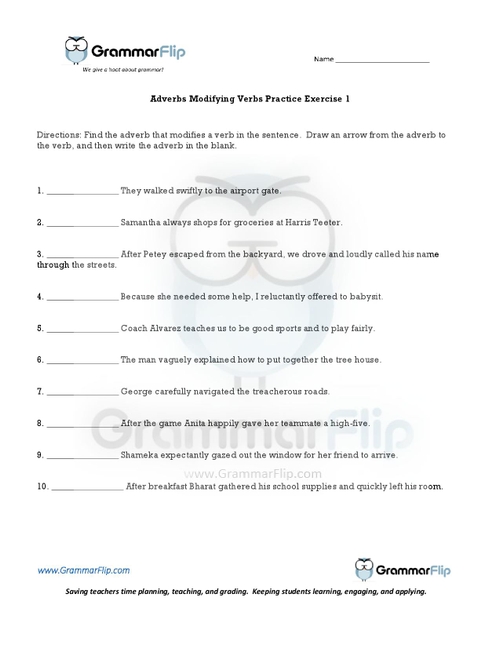What is an Adverb that Modifies a Verb?
An adverb is a part of speech that modifies a verb, an adjective, or another adverb. When modifying verbs, adverbs answer questions about where, when, how, and to what extent an action took place.
Some examples of adverbs modifying verbs would be the following:
I rode a bus here. (Where did I ride a bus?)
Sasha barely passed her science quiz. (To what extent did Sasha pass her science quiz?)
Grant silently wrote in his journal. (How did Grant write in his journal?)
I will exercise tomorrow. (When will I exercise?)
Long-Form Video: Adverbs Modifying Verbs
Long-form instructional video lessons allow students to engage with grammar concepts in more depth and detail.
This format provides students with a stronger foundation and a more comprehensive understanding of adverbs modifying verbs.
Grammar-in-Context Video: Adverbs Modifying Verbs
GrammarFlip’s grammar-in-context videos provide an additional layer of instruction, learning, and relatability.
Our unique and memorable video footage helps solidify the understanding of challenging grammar concepts.
Watch this video to better understand how adverbs can modify verbs!
Why You Should Use Adverbs That Modify Verbs in Your Writing
Why shouldn’t you use adverbs in your writing?! Adverbs provide so much depth and color to your writing, but for now, we’ll mention two primary reasons for using adverbs: description and precision.
Description: Adverbs modify (or alter) verbs, adjectives, and other adverbs. In a similar fashion, they are to verbs (and adjectives and adverbs) what adjectives are to nouns. In other words, they “describe” verbs, adjectives, and other adverbs. Notice the difference between the sentence with an adverb and without an adverb:
Without an Adverb: She sang the song.
With an Adverb: She sang the song beautifully.
Precision: Adverbs help you as a writer provide very specific detail so that you can convey your thoughts much more precisely.
Without an Adverb: I broke the glass window.
With an Adverb: I intentionally broke the glass window.
Notice the difference between the two sentences? The second sentence conveys much more detail than the first and reveals a good bit more context for your reader.
Use adverbs to keep your writing descriptive and precise!
Download a Free Worksheet on Adverbs Modifying Verbs!
Click the image below to download your free worksheet on adverbs modifying verbs!

Are some of your students struggling to understand adverbs?
Explore More GrammarFlip Lessons!
Parts of Speech lessons provide the building blocks of grammar. GrammarFlip covers these topics in detail to ensure a solid foundation is built. First time learners and students seeking to review the parts of speech can both benefit from the instructional videos and slide show reviews.
Parts of the Sentence lessons are critical for understanding how the parts of speech function in language construction. From the basic to the advanced, these lessons will cover a wide range of grammar topics that can be used in any grade level or classroom.
Mechanics and Usage lessons equip students with the necessary skills to communicate clearly to all audiences. With a focus on the application of these concepts in student writing, these lessons tie together both simple constructions of grammar as well as the more complex such that any age or skill level of student will benefit.

